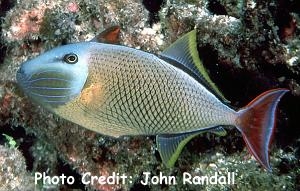
By Bob Goemans

Likely Reef Tank Suitable
Likely Fish-Only Tank Suitable
Range: Western Pacific Ocean: Ryukyu Islands south to Wake and Hawaiian Islands, and in the Eastern Pacific Ocean: southern California, Pitcairn, Easter, Clipperton and Galapagos Islands.
Size: 12 inches (30 cm)
Natural Environment: Inhabits near shore seaward reefs above dropoff areas at depths of about 20 – 400 feet (6 – 120 m) and has a natural diet of zooplankton. Seeks caves in the reef structure to hide or rest during evening hours.
General Husbandry: Definitely an attractive fish and somewhat mild-mannered, making it a good choice for community-style reef or fish-only aquariums. The male has a more intense yellow background color on the body, which sports a crosshatch design, i.e., black lines that criss-cross along the body, and a red tail. The female’s body is somewhat darker with the crosshatch design, and has a yellow-fringed tail. Both have blue radiating lines on the face.
In the home aquarium, they require a meaty diet, e.g., fortified brine shrimp, mysis, chopped fish, shrimp, squid, and clam flesh, and/or meaty type frozen carnivore foods with two or three feedings per day highly recommended. Some people say they are reef safe, yet, that’s not a proven fact, as small fish, ornamental shrimp, snails, urchins and worms such as feather dusters are at risk! Therefore caution is advised. Yet corals, soft and stony are not at risk.
Keep in mind that generally its recommended not more than one triggerfish be kept per aquarium unless a mated pair, and furthermore, that it be the last fish to be placed into the aquarium.
Taxonomy:
Order: Tetraodontiformes
Suborder: Tetraodontoidei
Family: Balistidae
Genus: Xanthichthys
FYI: Their common name, triggerfish, comes from their ability to lock and unlock their first dorsal fin. This fin is normally retracted and carried in a groove on the upper body. When frightened, the fish will dart into a crevice or branch of coral and raise this trigger-like fin, securely locking itself into its place of protection.
They should be housed with small pieces of seashells since they like to bite on them or turn them over in the search of prey. Better these shells than other aquarium decor. It also helps keep their teeth worn-down, which actually could get too long and pointed and cause them some difficulty in feeding.
In general, triggerfish are like angelfish and surgeonfishes, as they have laterally compressed bodies with small mouths with strong jaws and chisel-like teeth for crushing hard-shelled prey. However, eyes are set back and located high on their large head to avoid damage when feeding on urchins, one of their favorite foods.
Especially fond of live urchins, which they turn over with jets of water from their mouth, then consume their meaty unprotected bottom areas.
Even though specimen and confines specific, those in the genera Balistes, Balistoides, Pseudobalistes, Rhinecanthus, and Sufflamen are generally thought of as the most aggressive in the Triggerfish family. Those in the Melichthys, Odonus and Xanthichthys genera are more suitable community fish candidates, yet all are not trust worthy when it comes to invertebrates as mentioned above.
Care Level: Easy
Temperament: Semi-aggressive
Diet: Carnivore
Acclimation Time: 15 minutes+
Aquarium Environment: Fish-only and reef aquariums
Coral Safe: Yes
Invertebrate Safe: (See above)
Tankmates: Preferably equal in size or larger
Minimum Tank Size: 125 gallons
Temperature Range: 72 - 82°F (22 – 27°C).
Specific Gravity: 1.020-1.026
pH: 7.9 - 8.5
